
The Battle of Auray took place on 29 September 1364 at the Breton-French town of Auray. This battle was the decisive confrontation of the Breton War of Succession, a part of the Hundred Years' War.

John IV the Conqueror KG, was Duke of Brittany and Count of Montfort from 1345 until his death and 7th Earl of Richmond from 1372 until his death.
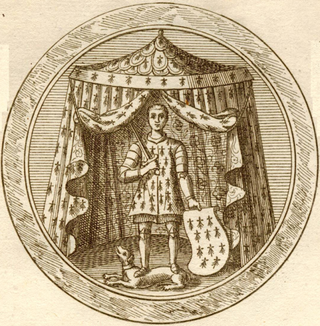
John V, sometimes numbered as VI, bynamed John the Wise, was Duke of Brittany and Count of Montfort from 1399 to his death. His rule coincided with the height of the Hundred Years' War between England and France. John's reversals in that conflict, as well as in other internal struggles in France, served to strengthen his duchy and to maintain its independence.

The House of Rohan is a Breton family of viscounts, later dukes and princes in the French nobility, coming from the locality of Rohan in Brittany. Their line descends from the viscounts of Porhoët and is said to trace back to the legendary Conan Meriadoc. Through the Porhoët, the Rohan are related to the Dukes of Brittany, with whom the family intermingled again after its inception. During the Middle Ages, it was one of the most powerful families in the Duchy of Brittany. They developed ties with the French and English royal houses as well, and played an important role in French and European history.
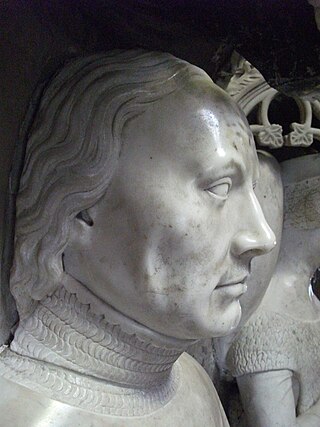
Olivier V de Clisson, nicknamed "The Butcher", was a Breton soldier, the son of Olivier IV de Clisson. His father had been put to death by the French in 1343 on the suspicion of having willingly given up the city of Vannes to the English.
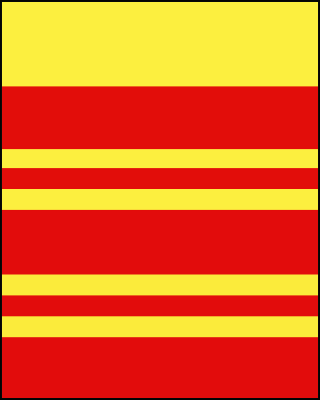
In the 11th and 12th centuries the Countship of Penthièvre in Brittany belonged to a branch of the sovereign House of Brittany. It initially belonged to the House of Rennes. Alan III, Duke of Brittany, gave it to his brother Eudes in 1035, and his descendants formed a cadet branch of the ducal house.

The Mad War was a late medieval conflict between a coalition of feudal lords and the French monarchy. It occurred during the regency of Anne of Beaujeu in the period after the death of Louis XI and before the majority of Charles VIII. The war began in 1485 and ended in 1488.

Gétigné is a commune in the department of Loire-Atlantique in the Pays de la Loire region in western France.

The Château de Brest is a castle in Brest, Finistère, France. The oldest monument in the town, it is located at the mouth of the river Penfeld at the heart of the roadstead of Brest, one of the largest roadsteads in the world. From the Roman castellum to Vauban's citadel, the site has over 1700 years of history, holding right up to the present day its original role as a military fortress and a strategic location of the highest importance. It is thus the oldest castle in the world still in use, and was classified as a monument historique on 21 March 1923.

The Château de Clisson is a castle in the commune of Clisson in the Loire-Atlantique département of France. It stands on the right bank of the Sèvre Nantaise.

The Château de Blain or Château de la Groulais, is a mediaeval castle constructed in the 13th century and heavily remodelled in the 16th, located in the commune of Blain in the Loire-Atlantique département of France. It formed part of the frontier defences of Brittany along with the towns and castles of Vitré, Fougères, Châteaubriant, Ancenis and Clisson.

Josselin Castle is a medieval castle at Josselin, in the Morbihan department of Brittany, France, first built in 1008 by Guéthénoc, viscount of Porhoët. The town and castle were named after Guéthénoc's son, Goscelinus, and rebuilt at various times since. The current castle was built by Olivier V de Clisson after 1370. He had acquired the land as part of the dowry on his marriage to Margaret of Rohan. It has been designated as a monument historique since 1928.

Jeanne de Clisson (1300–1359), also known as Jeanne de Belleville and the Lioness of Brittany, was a French / Breton former noblewoman who became a privateer to avenge her husband after he was executed for treason by the French King Philip VI. She crossed the English Channel targeting French ships and often slaughtering their crew. It was her practice to leave at least one sailor alive to carry her message of vengeance.

The sieges of Vannes of 1342 were a series of four sieges of the town of Vannes that occurred throughout 1342. Two rival claimants to the Duchy of Brittany, John of Montfort and Charles of Blois, competed for Vannes throughout this civil war from 1341 to 1365. The successive sieges ruined Vannes and its surrounding countryside. Vannes was eventually sold off in a truce between England and France, signed in January 1343 in Malestroit. Saved by an appeal of Pope Clement VI, Vannes remained in the hands of its own rulers, but ultimately resided under English control from September 1343 till the end of the war in 1365.
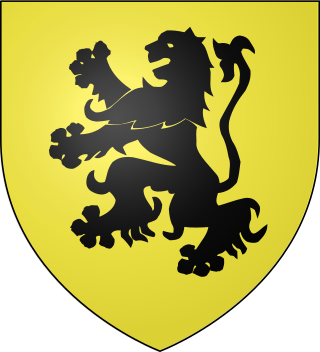
Herve VII of Léon was a Breton lord, son of Herve VI, Lord of Léon and his wife Joanna of Montmorency. Also known as Herve. He succeeded his father as Lord of Léon in 1337. He was also Lord of Noyon-sur-Andelle. The Lords of Léon were a junior branch of the Viscounts of Léon which was founded by Harvey I, second son of Guihomar IV, Viscount of Léon. Herve VII won fame during the War of the Breton Succession.

John I, was Count of Penthièvre and Viscount of Limoges from 1364 to 1404, and the Penthièvre claimant to the Duchy of Brittany.
Olivier was Count of Penthièvre and Lord of Avesnes from 1404 until his death.
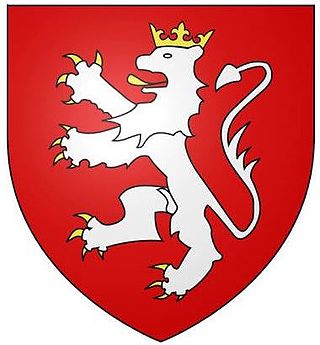
Olivier IV de Clisson (1300–1343), was a Breton Marche Lord and knight who became embroiled in the intrigue of Vannes and was subsequently executed by the King of France for perceived treason. He was the husband of Jeanne de Clisson who eventually became known as the Lioness of Brittany.

Olivier I de Clisson was a Breton frontier lord. He is mainly remembered for his conflict with his half-brothers and the Duke of Brittany.
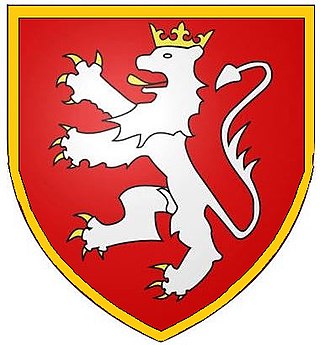
Amaury de Clisson (1304–1347), was a Breton knight who became the chief emissary for Jeanne de Penthièvre to the court of Edward III of England.



















